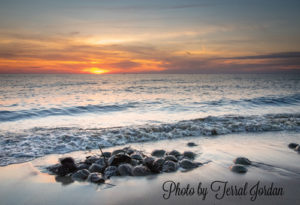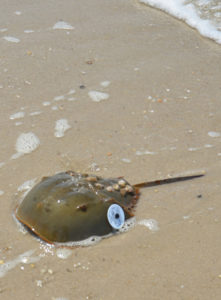by Sue Slotterback
 An annual ritual is about to commence along our shoreline. It’s time for the migration and spawning of horseshoe crabs. Known as a “living fossil”, horseshoe crabs date back more than 450 million years! They are closely related to spiders, ticks, and scorpions. Limulus polyphemus, the American Horseshoe Crab, is found from Maine to the Yucatan Peninsula. The largest population of spawning horseshoe crabs in the world can be found in Delaware Bay. In late April, horseshoe crabs begin their migration from the deeper offshore ocean waters into the bay. With a male in tow, the female comes ashore on the incoming tide. She digs herself into the sand and with external fertilization from the male, begins to lay sticky, green eggs. As the tide rises, the pair moves up the beach laying more nests along the way. When the tide recedes, they move into the shallows to wait for the next incoming tide. They will continue coming ashore, especially on the higher night time tides, to lay eggs until she has laid her 80,000 to 100,000 eggs for the season.
An annual ritual is about to commence along our shoreline. It’s time for the migration and spawning of horseshoe crabs. Known as a “living fossil”, horseshoe crabs date back more than 450 million years! They are closely related to spiders, ticks, and scorpions. Limulus polyphemus, the American Horseshoe Crab, is found from Maine to the Yucatan Peninsula. The largest population of spawning horseshoe crabs in the world can be found in Delaware Bay. In late April, horseshoe crabs begin their migration from the deeper offshore ocean waters into the bay. With a male in tow, the female comes ashore on the incoming tide. She digs herself into the sand and with external fertilization from the male, begins to lay sticky, green eggs. As the tide rises, the pair moves up the beach laying more nests along the way. When the tide recedes, they move into the shallows to wait for the next incoming tide. They will continue coming ashore, especially on the higher night time tides, to lay eggs until she has laid her 80,000 to 100,000 eggs for the season.
At the same time, millions of shorebirds from Central and South America descend on these same shores, their rest stop along a 3,000 – 9,000 mile annual journey to their Arctic breeding grounds. When the birds arrive, they are starving, having used up all their reserves on their long frequently non-stop flight. They must find food and horseshoe crab eggs are perfect: packed with fat and protein, and easily found as each wave of spawning crabs unearth some of the previously laid eggs.
Humans have a long connection to horseshoe crabs. Native Americans ate their eggs. In the 1800s and early 1900s, a thriving industry on the Delaware Bay collected horseshoe crabs by the millions. They were dried, ground and used to fertilize crops and feed hogs. Perhaps their most important connection to humans is that their white blood cells contain a chemical called LAL, Limulus Amoebocyte Lysate. LAL is used to test for contaminants in all injectable drugs and vaccines; all internal prosthetics, like artificial knees, hips and pacemakers; contacts and contact solution; and it is the test for spinal meningitis.
 The 1980s saw a large increase in the number of horseshoe crabs being used as bait to catch eel and channeled whelk, mostly for overseas markets. This overharvesting is cited as a cause for the dramatic decline in shorebirds. As a result, the state of NJ has a moratorium placed on the harvesting of the crabs.
The 1980s saw a large increase in the number of horseshoe crabs being used as bait to catch eel and channeled whelk, mostly for overseas markets. This overharvesting is cited as a cause for the dramatic decline in shorebirds. As a result, the state of NJ has a moratorium placed on the harvesting of the crabs.
A key issue facing horseshoe crabs is a lack of adequate spawning habitat. With its calm, shallow waters and gentle sloping beaches, Delaware Bay beaches are perfect spawning habitat. Development along the waterfront with bulkheads reaching the high tide line leaves little access for the crabs to spawn. Restoration efforts have focused on improving sand reserves on Delaware Bay beaches and working to remove hazards that entrap crabs. The reTURN the Favor project works to rescue stranded horseshoe crabs. As horseshoe crabs come onto the beaches they often get caught in exposed rubble, or get turned upside down in the waves and stranded. RTF project volunteers help by freeing crabs and work on projects to help remove debris from beaches.
Our Spring Shorebird and Horseshoe Crab Festival, May 20-21, has workshops, demonstrations, and field trips that focus on the crabs and their role in shorebird migration. Volunteers can help with horseshoe crab spawning surveys, horseshoe crab tagging, and reTURN the Favor walks (returnthefavornj.org) from May to June. Reach out and connect with this ancient phenomenon right here in Cape May County’s backyard.
